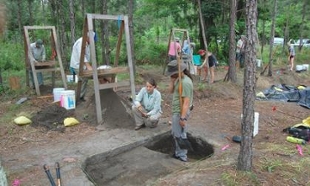Students explore early contact between Spanish, Native Americans
News
Seven undergraduate students from James Madison University spent six weeks in southern Georgia this summer helping uncover evidence of first encounters between Native American Indian communities and Spanish explorers during the 16th and 17th centuries.
The summer archaeological field school, under the direction of JMU assistant professor of anthropology Dr. Dennis Blanton, was designed to advance the research agenda Blanton implemented at the Fernbank Museum of Natural History beginning in 2005.
- Throughout the six-week session, students received instruction in field methodologies including excavation, record-keeping, initial laboratory processing and soil sampling, and ultimately became responsible for implementing the research program.
- The focus was on two Native American communities likely visited by Hernando de Soto in 1540 — a 16th century Indian village at the edge of an abandoned channel of the Ocmulgee River near Jacksonville, Ga., and a large, virtually undocumented Mississippian mound located on a plantation in Dougherty County, Ga.
“In the beginning, we needed assistance and explanations every step of the way,” said senior David Jezierski, a math major who, in addition to learning basic archaeological skills, helped design sampling strategies for one of the sites. “However, by the time we left the first site, we were capable of performing an entire unit excavation, creating and maintaining all records, and sharing with interested citizens the nature of our work through demonstration and spoken word.”
Digging for clues in the Georgia heat proved demanding in nearly every sense of the word — physically, emotionally and intellectually.
“It’s really important to stay focused,” said Taylor Golding, a senior biological anthropology major. “We were studying people who would never talk again, who couldn't tell us their story. All we really had to go on were the artifacts these people left behind and the clues we could find in the soil. If you lost focus, you could unintentionally mess up … and when that happens, you essentially destroy a part of the human story.”
The team made some interesting discoveries along the way, Jezierski said. “We are much closer to understanding the layout of both towns, and there was a glass bead discovered at both sites. This may not seem like a big deal, but those discoveries could quite possibly lead to some changes in history books related to that area and time period.”
“We were all highly invested in the work we did in Georgia. We wanted the end result to be something we could be proud of,” added senior anthropology major Aaron Lovejoy. “When work in the field was not done to the high standards we and Dr. Blanton had set, we worked hard, even extra hours to make sure we got back on track. I think the program's end result reflects that work ethic.”
Careful analysis of the artifacts and other findings will be completed over the coming months, after which a detailed report will be prepared.
###

